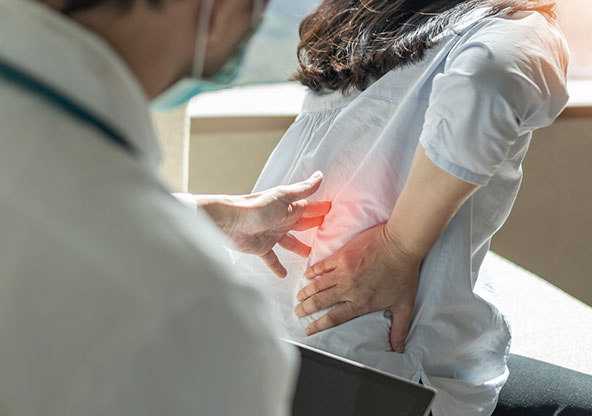9 Ways to Relieve Low Back Pain
Lower spine pain is a widespread problem that can hinder living a fulfilling life.
Several issues can cause lower spine pain, including poor posture, poor ergonomics, muscle imbalances, arthritis, disc herniation, spinal stenosis, osteoarthritis, or spondylolisthesis.
Lower back pain can arise at any point in your daily activities. For example, it can flare up while playing sports, cleaning your house, doing lawn work, or just bending over. The issue with lower spine pain is that it can be long-lasting.
Chronic Back Problems
Below we share several tips and habits that can assist you to relieve back pain. However, if you suffer from chronic lower back pain, you should schedule an appointment with a physical therapist or a doctor. These tips are not medical advice; if back pain is severe, you should consult your primary care physician for the best treatment options.
If your discomfort is in the mid-back, you should learn when to worry about middle back pain and seek care accordingly.
1) Apply heat or ice to the affected area
Heat: Using a heating pad can reduce lower spine pain and swelling. When heat is applied to the lower spine, it can improve the soft tissue's overall flexibility and muscles' movement. Heat also speeds up the healing of muscles.
Cold: Applying cold can narrow the blood vessels to reduce swelling, decrease inflammation and cause a numbing effect. Applying ice first and then heat reduces pain.
Read more about using heat vs. ice for pain.
2) Wearing a supportive back brace
- A back brace can support lower back pain by giving better support to the lower back and helping the spine better align itself.
- A back brace relieves pressure on the discs and nerves in the lower back.
- A back brace can prevent injuries and support a healthy spine. It will also keep your body in the proper posture.
3) Wear Supportive Socks and Shoes
Shoes with shock absorptions and cushioning help relieve direct pressure points. Arch support is a plus because it can help take the pressure off the lower back and spine.
These shoes can reduce the impact walking and running have on your lower back. In addition, lots of cushioning have become beneficial in helping people reduce spine pain.
4) Practice Good Posture
Maintaining good posture is one of the best ways to prevent lower back pain. Good posture is strongly suggested when sitting, standing, or moving. Doing so can keep the spine in alignment by preventing muscle and joint strain.
Good posture can help reduce the risk of developing herniated discs and degenerative disc disease.
5) Stretching and Exercising
Stretching: Consistently stretching and exercising can help improve posture and prevent lower back pain.
One of the best ways to reduce and or eliminate back pain is to stretch muscles on or near the spine. When these spine muscles are tight, it can cause the spine to be misaligned, causing pain.
Exercise: Regular exercise can help lower back pain by strengthening the muscles in the back and its ability to improve flexibility.
Exercise can also help reduce inflammation and improve blood circulation. In addition, low-impact activities such as walking, swimming, or stretching can alleviate lower back pain.
6) Take breaks during prolonged periods of sitting or standing
When people sit for extended periods, the muscles and joints become stiff, leading to discomfort when moving around.
Taking breaks gives our muscles and joints a chance to be flexible, relieving stress on the lower spine.
Taking a three to five-minute walking break at work can help those suffering from lower back pain. When we move around, it can also cause our minds to put less focus on the pain.
7) Sleeping on a Firm Mattress
Sleeping on a firm mattress can relieve lower back pain by providing the necessary support for the spine and its ability to relieve pressure on the joints.
In addition, sleeping on a firm mattress helps the spine maintain alignment, and it also helps prevent the hips from sinking into the bed.
Lastly, a firm mattress helps distribute body weight more evenly, reducing pressure on the spine and joints.
8) Maintain a Healthy Body Weight
Getting rid of extra pounds can lighten the burden on your lower back. However, extra pounds can cause too much force on the lower spine.
Consult with your doctor to receive advice about how to get rid of lower spine pain. Advice may include exercise recommendations or a diet plan to help you recover and prevent lower spine pain.
9) Stop smoking
A person who smokes is at a greater risk than non-smokers of suffering from degenerative disk disease and other spine issues.
The nicotine from smoking can weaken the bones in your spine and reduce essential nutrients.
In addition, nicotine decreases blood vessels leading to degenerative disk disease, which is a leading cause of lower spine pain and spine stiffness.
Have You Tried Physical Therapy?
Everyone's pain is different, and the best way to treat lower back pain can require unique treatment plans for each person suffering from spine and back problems.
Physical therapy can assist in relieving lower back discomfort by strengthening the muscles in the back and improving flexibility and range of motion.
Physical therapy may also aid in correcting posture and reducing strain on the back. In certain situations, physical therapy can be combined with other types of treatment, such as massage or chiropractic care, to provide even more relief from lower back pain.
Take a Spine Health Assessment
Take this assessment to determine the health of your spine. The CHRISTUS Health spine assessment measures your risk of heart disease by asking simple questions.


